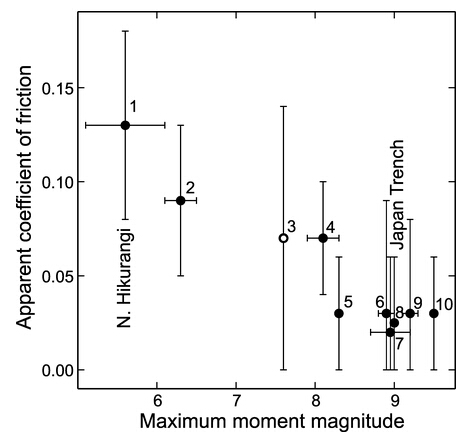On August 29, Science published a paper entitled "Strength of stick-slip and creeping subduction megathrusts from heat flow observations" by Xiang Gao, Chinese Academy of Sciences, and Kelin Wang, GSC-Pacific. The main finding of this paper is that smooth subduction megathrusts that produce great earthquakes are weaker, but rugged megathrusts that creep are stronger.
Subduction megathrusts can produce devastating earthquakes and tsunamis. Examples include the M 9.2 Sumatra earthquake in 2004 and M 9.0 Japan earthquake in 2011 and their tsunamis. For hazard assessment and risk mitigation, it is important to know what geophysical conditions promote or hinder the generation of these events. One outstanding question is the relation between the strength of megathrust faults and their seismogenic behaviour. It has been commonly assumed that stronger faults produce larger earthquakes. In this new Science paper, Gao and Wang show that the opposite is true.
Gao and Wang numerically simulated frictional heating from various subduction megathrusts and used heat flow measurements as constraints. They found that megathrusts that produce great earthquakes generate less frictional heat than those that creep. The lower frictional heating indicates weaker faults. The correlation between the fault strength represented by apparent friction and the maximum size interplate earthquake for all the subduction zones studied is shown below (Fig.). They explained that megathrust strength and seismogenic behavior are controlled by the ruggedness of the subducting seafloor, with smoother seafloor leading to weaker faults and larger earthquakes.

Fig. Apparent friction of megathrust vs. maximum size of clearly documented interplate earthquake:
1 – Northern Hikurangi, 2 – Manila Trench, 3 – Costa Rica, 4 – Kermadec, 5 – Nankai, 6 – Kamchatka,
7 – northern Cascadia, 8 –Japan Trench, 9 – Sumatra, and 10 – south-central Chile
This study provides a better understanding of the importance of fault strength on slip behavior and a new perspective on the geological conditions of great earthquakes. Thus it not only improves our knowledge of the physics of earthquakes but also our ability to assess seismic and tsunami hazards for risk mitigation.

